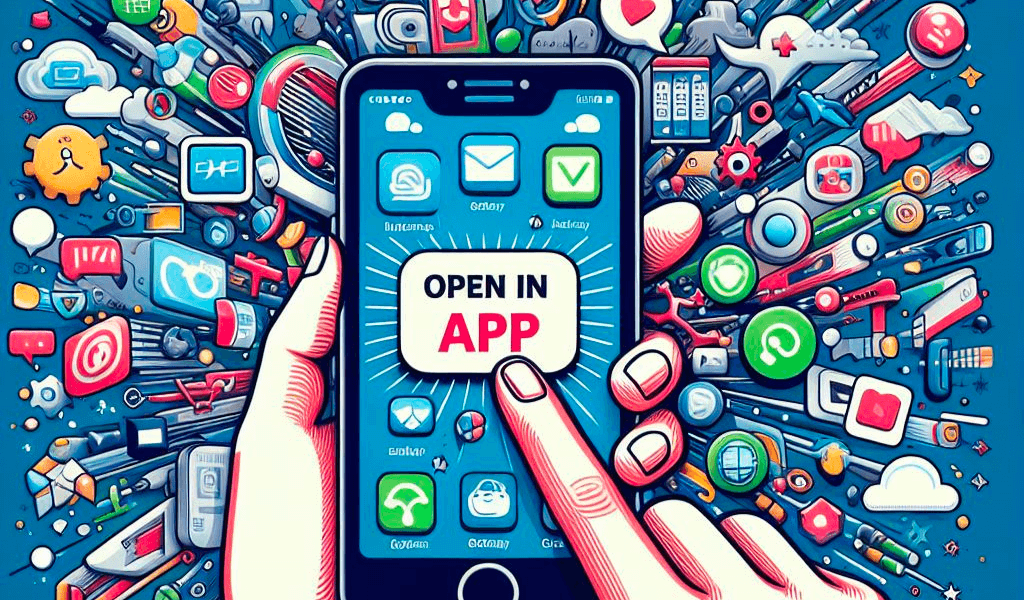
If you’re tired of switching back and forth between your mobile browser and different apps, then for you app deep linking is the best solution. By opening links directly in the app, you can enjoy a more seamless browsing experience and take advantage of all the benefits of mobile app deep linking. In this article, I will guide you through the process of implementing app deep linking, exploring the benefits, best practices, and troubleshooting tips to ensure optimal functionality. Are you ready to take your mobile browsing to the next level? Let’s get started!
Understanding App Deep Linking
Have you ever clicked on a link from a mobile browser and been redirected to the same website’s homepage instead of the specific location you intended to visit within the app? App deep linking provides a solution to this frustrating issue.
App deep linking allows users to open links directly in the app, rather than being redirected to a web browser. By leveraging app links and redirects, users can transition seamlessly from web to app without any additional effort.
Benefits of Deep Linking to App
Deep linking to your mobile app offers various benefits in enhancing the user experience and increasing engagement. By opening links directly in the app, users are provided with a seamless journey and an improved browsing experience.
With deep linking, users are taken directly to the relevant content within the app without navigating through the app manually. This not only saves time and effort but also offers a more personalized experience, enhancing engagement and keeping users connected with your brand.
Deep linking to your app also provides enhanced app functionality, including the ability to easily share content and offer in-app purchases, all of which contribute to a more accessible and user-friendly experience.
Streamlining the User Journey
Opening links in the app streamlines the user journey, resulting in higher user retention rates and increased app usage. By providing a seamless transition from a website to the app, users are more likely to continue their journey within the app.
Additionally, deep linking to your app can provide valuable user data, allowing you to analyze user behavior and optimize your app’s user experience.
Overall, by utilizing deep linking to your mobile app, you can enhance user experience, increase engagement, and gather valuable user data for continued optimization of your app.
Implementing Deep Linking in Your App
Implementing deep linking in your mobile app is key to providing a seamless user experience. There are various methods to accomplish this, including:
| Method | Description |
|---|---|
| URI Schemes | This entails using unique URI schemes to link to specific pages within your app. It’s supported across all platforms, but the downside is that it requires manually setting up links in code. |
| Universal Links | This is an iOS-only method that uses a website association file to map web URLs to specific app pages. Once set up, it allows for accurate tracking and can pass data between the app and website. |
| App Links | This is an Android-only equivalent of Universal Links that allows URLs to direct to specific app pages. It’s more flexible than URI schemes and can be set up using Android Studio or by adding meta tags to your web pages. |
Once you’ve selected a method, it’s crucial to test for optimal functionality across different platforms and devices. You should also consider adding fallbacks in case the app is not installed on the user’s device or the link is broken.
Deep Linking Best Practices
Implementing deep linking within your app is a great way to provide a seamless user experience, but it’s important to follow best practices to ensure optimal functionality. When creating a deep linking strategy, keep the following tips in mind:
Create Seamless Transitions
When a user clicks on a link, they want to redirect directly to the relevant content within your app using link generation tool. Ensure that the transition from the link to the app is smooth and instantaneous. Avoid displaying any intermediate pages or splash screens that could disrupt the user flow.
Handle Fallbacks
Not all users will have your app installed on their device, so you need to have a fallback in place for those cases. Implement smart app banners or a custom error message that prompts the user to download the app or continue browsing the website.
Ensure Cohesive User Experience
Deep linking can enhance the user experience by providing quick, easy access to relevant content. However, it’s important to ensure that the content displayed within the app is consistent with the user’s expectations. Keep the branding, navigation, and functionality consistent between the linking source and the app.
By following these best practices, you can ensure that your app deep linking strategy provides a seamless user experience and maximizes engagement.
Troubleshooting Deep Linking Issues
While deep linking to your mobile app can significantly improve the user experience, certain issues may arise that interrupt a smooth transition from a web browser to your app. Understanding how to troubleshoot these issues is crucial, ensuring that your users receive the intended experience.
Incorrect Link Handling
One of the most common issues with deep linking is incorrect link handling. This can happen when there are multiple entry points into your app or when the link is not associated with any specific content in your app. If you encounter this issue, double-check your deep link handling code to make sure it’s correctly identifying the intended entry point and content.
Broken Deep Links
Broken deep links, or links that don’t work, can result from incorrect implementation or changes to your app’s structure. If you’re encountering broken deep links, start by verifying that the link is correctly formatted and ensure that any changes to your app’s structure are reflected in the deep linking code.
Fallback Handling
When deep linking fails, fallback handling provides an alternative entry point into your app. However, if fallback handling is not configured correctly, it can result in confusing user experiences. Make sure that your fallback handling is configured appropriately, and that users are directed to relevant content.
By addressing these common deep linking issues, you can optimize your mobile app deep linking and provide a seamless browsing experience for your users.
Future of Deep Linking in Apps
The future of app deep linking holds great promise for enhancing the mobile browsing experience. As technology continues to evolve, we can expect to see even more seamless integration between web browsers and mobile apps.
One emerging trend in deep linking technology is the ability to deeplink directly into specific sections or content within an app, rather than just the app’s home screen. This creates an even more personalized and efficient user experience.
Another development in deep linking is the use of deferred deep linking, which allows users who don’t have the app installed to be linked directly to the content in the app after downloading it. This simplifies the user journey and eliminates the need for additional steps.
As the benefits of deep linking become more apparent, we can expect to see this technology used in more creative ways beyond just the standard use cases.
Conclusion
In summary, implementing app deep linking and opening links directly in the app can significantly enhance the mobile browsing experience. By utilizing app links and redirects, users can seamlessly transition from a web browser to a mobile app and enjoy improved functionality and engagement.
It’s essential to understand the benefits of deep linking to an app, including streamlined user journeys, increased engagement, and enhanced app functionality. By implementing app deep linking in your mobile app, you can improve the user experience and increase user retention.
As with any feature, there are best practices to follow when incorporating app deep linking. Creating seamless transitions, handling fallbacks, and ensuring a cohesive user experience are all critical considerations.
If issues with deep linking arise, troubleshooting techniques can be applied to solve problems such as incorrect link handling and broken deep links. It’s essential to stay up-to-date with emerging trends in deep linking technology to provide the best possible experience to your users.
Overall, opening links directly in the app through the use of app deep linking offers a smoother, more integrated mobile browsing experience. By implementing these strategies and best practices, you can ensure your mobile app stands out from the competition and provides users with unmatched user experience.

I help businesses optimize their online presence and reach more customers through search engines. I have been working in this field for over a year, and I have earned certifications from various platforms. I have experience in conducting SEO audits, developing link building strategies, and implementing SEO best practices for various clients across different industries. I am proficient in SEO tools, such as Google Analytics, Google Search Console, Moz, and Ahrefs. I am passionate about SEO and always eager to learn new skills and techniques to improve my performance and deliver results. My goal is to become a SEO leader and help businesses grow and succeed online.
